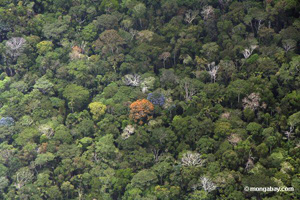Scientists seek to understand how climate will impact forest carbon
Scientists seek to understand how climate will impact forest carbon
STRI
March 5, 2008
Smithsonian Announces Global Forest Carbon Research Initiative
|
|
Forests contain nearly 40 percent of the world’s carbon—more than the atmosphere contains—but too little is known about forest carbon dynamics to predict whether anthropogenic global change will increase or decrease forest carbon pools. Helene Muller-Landau, staff scientist at the Smithsonian Tropical Research Institute, announced a major global research effort to quantify forest carbon pools and fluxes. She announced the new effort at the Climate Change in the Americas Symposium, held Feb. 25-29 at the institute’s headquarters in Panama.
Researchers from more than 70 institutions working in a network of 25 forest study sites currently monitor more than 3 million trees representing approximately 8,200 species—10 percent of the world’s total tree fauna. This Global Forest Observatory, which is coordinated by the Center for Tropical Forest Science at STRI, was originally set up to understand biodiversity but has become an ideal tool for determining the on-the-ground effects of global change.

|
Working with partners at 12 of the CTFS sites, Muller-Landau will assess carbon storage and movement by quantifying the amount of carbon in trees, soils, lianas and woody debris; determining annual carbon flux at different sites; and seeking explanations for movement of carbon through forest ecosystems. Finally, scientists will scale up the study from individual sites to the larger landscape level by collaborating with regional forest ecologists and remote sensing researchers.
Global warming has been driven by the burning of fossil fuels since the start of the industrial revolution. Current levels of atmospheric carbon have not been reached in the last 400,000 years. While there is evidence from the CTFS forest plots indicating that some forests are currently absorbing some of this excess carbon from the atmosphere, other studies suggest that global temperature increases are actually slowing tree growth and, therefore, carbon absorption. Rainfall patterns and drought frequency are expected to shift as well—also with unknown impacts on forest carbon budgets.
If forests absorb more carbon from the atmosphere than they release, this will slow the rise in atmospheric carbon dioxide and reduce associated climate change; in contrast, if forest releases exceed absorption, atmospheric and climate change will accelerate.
Initial work from the CTFS plots has already shown significant variation in the carbon stored in trees at sites across the network, as well as significant changes in carbon fluxes through time.
Funding from the HSBC Climate Partnership—in addition to supporting the carbon initiative— will support the first-ever landscape-level study in the tropics to understand the role of forests in biodiversity conservation and ecosystem services, as well as carbon storage.
Assessing Evidence for a Pervasive Alteration in Tropical Tree Communities
An analysis of changes in biomass and primary productivity across ten large tropical forest plots revealed that aboveground biomass increased significantly, fast-growing species increased significantly in dominance at a single site, and slow-growing species increased significantly at half of our sites.
Abstract Background
In Amazonian tropical forests, recent studies have reported increases in aboveground biomass and in primary productivity, as well as shifts in plant species composition favouring fast-growing species over slow-growing ones. This pervasive alteration of mature tropical forests was attributed to global environmental change, such as an increase in atmospheric CO2 concentration, nutrient deposition, temperature, drought frequency, and/or irradiance.
Abstract Findings
We used standardized, repeated measurements of over 2 million trees in ten large (16-52 ha each) forest plots on three continents to evaluate the generality of these findings across tropical forests. Aboveground biomass increased at seven of our ten plots, significantly so at four plots, and showed a large decrease at a single plot. Carbon accumulation pooled across sites was significant (+0.24 MgC ha-1 y-1, 95% confidence intervals [0.07, 0.39] MgC ha-1 y-1), but lower than reported previously for Amazonia. At three sites for which we had data for multiple census intervals, we found no concerted increase in biomass gain, in conflict with the increased productivity hypothesis. Over all ten plots, the fastest-growing quartile of species gained biomass (+0.33 [0.09, 0.55] % y-1) compared with the tree community as a whole (+0.15 % y-1); however, this significant trend was due to a single plot. Biomass of slow-growing species increased significantly when calculated over all plots (+0.21 [0.02, 0.37] % y-1), and in half of our plots when calculated individually.
Abstract Conclusion
Our results do not support the hypothesis that fast-growing species are consistently increasing in dominance in tropical tree communities. Instead, they suggest that our plots may be simultaneously recovering from past disturbances and affected by changes in resource availability. More long-term studies are necessary to clarify the contribution of global change to the functioning of tropical forests.]